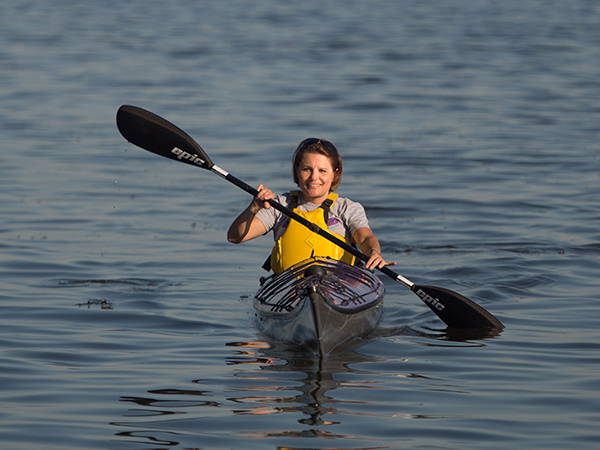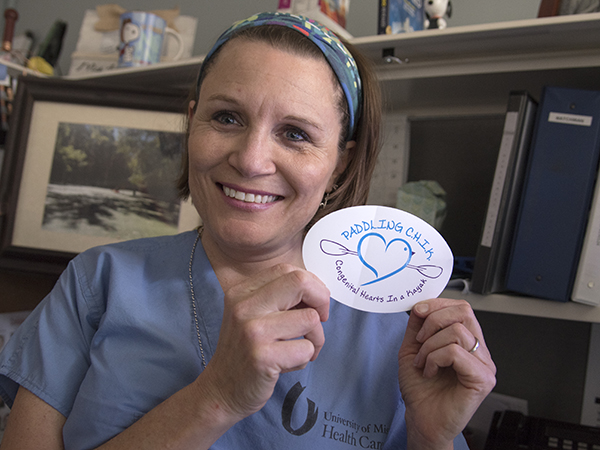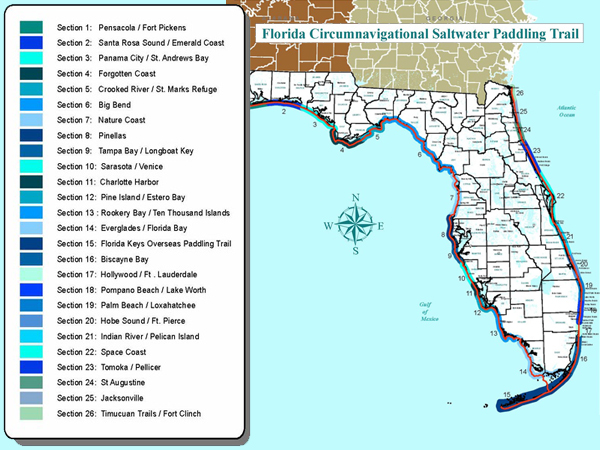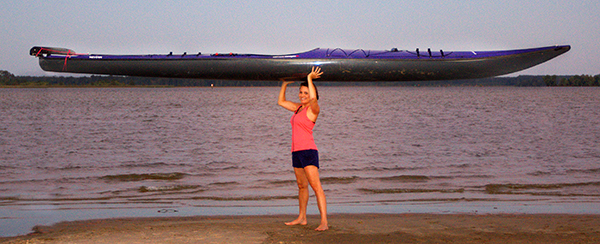People of the U: Camille Richards

Published in News Stories on March 20, 2017
If you refer to Camille Richards in terms of a “CHIK,” she won't get offended.
That's short for Congenital Hearts in a Kayak. Richards, the Medical Center's nurse practitioner director of the adult congenital heart program, is crusading to increase awareness and support for patients who were born with heart abnormalities. Most babies with the condition now survive and thrive, but often need continuing care as an adult.
Richards, who's been kayaking for about a decade, is using her avocation to call attention to the Adult Congenital Heart Association. She's paddling - in legs - 1,515 miles around the Florida coastline, starting at Pensacola and ending just north of Jacksonville.
You can keep up with her on her Facebook page, and on her blog.

Richards displays the sticker she designed to draw attention to her quest.
She began the first leg last Nov. 14, her birthday, completing 200 miles in 13 days. She's getting back on the water at Carabelle, Fla., for three weeks later this month or in early April and hopes to complete 400 miles.
Richards gets occasional land support from her family, including husband Peter, but otherwise she's on her own in waters that can be placid at their best and a stormy home to sharks and alligators at their worst. It will take her about two years, in two- to four-week increments, to finish.
“The journey is known as the Florida Circumnavigation Trail, and it has been completed by about 25 individuals, mostly men. Now you can see why people are asking if I'm crazy.
“I'm all about balancing the odds,” said Richards, who is serving a three-year term on the board of directors of the Adult Congenital Heart Association. She got the idea after not being able to generate enough interest with a 5K run, “so, I'm doing something I love to do.”

Richards is kayaking the 1,500-mile-plus Florida Circumnavigational Trail.
Through it all, Richards, not her immediate environment, is in control.
Her preparation is thorough, including planning every place she will tent-camp, and to the pound, what she will bring. Loaded, her almost 19-foot kayak is 160 pounds; alone, it's 40 pounds.
Richards is 5'3” and 120 pounds. Don't think she can't handle her kayak, including boosting it unloaded above her head.
“You're supposed to carry at least a gallon of drinking water a day, but since all of my food is freeze-dried, I have to use water to reconstitute it,” Richards said. “I pre-make all my food per day, so a day's worth of food is in a Ziploc - oatmeal with dried fruit, maybe dried eggs and nuts for lunch, or dried fruit and beef jerky or tuna. Dinner is a noodle dish with dried meat. And, I'm constantly snacking. “
Campsites can be found on the trail website. “People have marked places that are not formalized campgrounds, but you can go there,” Richards said. “There are state parks and national parks, and some private businesses have opened their doors to us. There are trail angels, people who volunteer to house people and bring in their gear and supplies.
Early in her first trip, her dad followed her in his sailboat for four days. “But once I got beyond where his boat could go, I was alone, in the water by myself, and on land by myself.”
She got a taste of how rough it can get pretty quickly when high winds kicked up. “I wasn't scared. I knew what I needed to do - get to shore. I knew where the next populated area was, and I used that as my landmark. I got to shore behind a group of houses, and I found a guy who drove me about eight miles down the road to my dad in his sailboat so that I could regroup.”
The man and his wife “were so nice. They went on my website and made a donation,” Richards said.
Later in that trip, “my husband Peter met up with me before Thanksgiving to paddle. The park that we pulled up on wasn't in the greatest section of town. We stayed in a hotel that didn't feel safe, either,” she said.
“I felt much safer the next night when I was camping in the middle of nowhere,” she said. “A female by myself … I can handle myself in the middle of the wilderness. I can't necessarily control people.”
Even so, you would do well not to mess with Richards. She carries a machete and bear spray, and she's never been lonely or afraid. “I'm always so tired at the end of the day that I don't even think about it,” she said.

With a little help from friends, Richards hoists her 40-pound kayak.
She's on the water for hours, giving her time to think and to improve her technique. “I do a lot of figuring out how to paddle without it hurting,” she said. “I think about my congenital heart patients. A lot of them can't do extreme exercises.
“The main thing I've seen so far is sting rays, hundreds near Panama City,” she said. “I've seen a manatee and lots of dolphins. Once when I camped, I saw evidence of a bear, but not the bear. I had a raccoon get into my boat one night and puncture my Camelback. Fresh water is an issue for me, but it's also an issue for animals.”
Richards stays ready for any weather and any temperatures, including the night it plummeted to 34 degrees. And then, there are warm days “when it's completely calm and clear. I can do a lot of miles.”
What happens when a kayaker, even an expert, tips over in rough waves? Richards doesn't plan to find out. “You don't want to get yourself into a situation where you could roll. I took a roll class to learn how to roll your kayak back over,” she said. If you aren't successful there, Richards said, you learn how to exit it.
Thanks to technology, her parents and friends can find her through a GPS app on their phones. “I have solar panels to charge my gear, an iPad, a cell phone and a GPS tracking device,” Richards said.
Richards is footing all costs of her journey. She's grateful for those who donate not to her, but to the ACHA through her blog, “My goal is at least $4,000 to $5,000 per trip for the ACHA, and I made a little over $4,000 on the first trip,” Richards said.
Her coworkers are awed by her journey. “It's easy to give money to the association, but it's something else to try to raise funds for it,” said Teresa Temple, an administrative assistant in the congenital heart program. “It's amazing how people are willing to help her, and the things she has overcome.”
The November leg is affirmation that Richards can do it. “I wanted to do the first stint as a proving ground,” she said.
“My husband knows I can handle myself on the water and on the land. He said he feels bad for any person or animal who tries to get in my way.”


